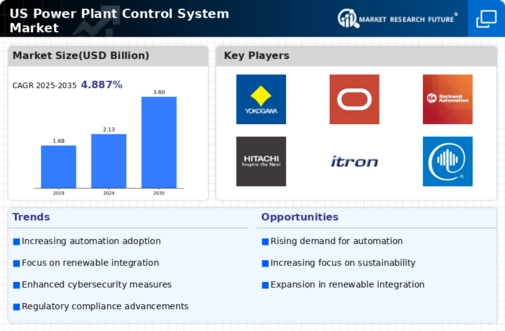Rising Demand for Energy Efficiency
The power plant-control-system market is experiencing a notable surge in demand for energy efficiency solutions. As energy costs continue to rise, operators are increasingly seeking systems that optimize performance and reduce waste. This trend is driven by regulatory pressures and the need for cost-effective operations. In 2025, energy efficiency measures are projected to save the US economy approximately $1 trillion over the next decade. Consequently, the power plant-control-system market is adapting to incorporate advanced analytics and real-time monitoring capabilities, which enhance operational efficiency and reduce emissions. This shift not only aligns with environmental goals but also supports financial sustainability for power producers.
Shift Towards Renewable Energy Sources
The transition towards renewable energy sources is a pivotal driver for the power plant-control-system market. As the US aims to achieve a 50% reduction in greenhouse gas emissions by 2030, there is a growing emphasis on integrating renewable energy into the existing grid. This shift necessitates advanced control systems capable of managing the variability and intermittency associated with renewable sources such as solar and wind. By 2025, investments in renewable energy technologies are projected to reach $200 billion, creating substantial opportunities for the power plant-control-system market to develop solutions that facilitate this transition.
Regulatory Compliance and Safety Standards
The power plant-control-system market is significantly influenced by stringent regulatory compliance and safety standards. In the US, the Environmental Protection Agency (EPA) has implemented various regulations aimed at reducing emissions and ensuring safe operations. Compliance with these regulations necessitates the adoption of advanced control systems that can monitor and report emissions accurately. As of 2025, it is estimated that compliance-related investments in the power sector will exceed $50 billion. This creates a robust demand for sophisticated control systems that can facilitate adherence to these regulations while enhancing operational safety and reliability.
Technological Advancements in Control Systems
Technological advancements are reshaping the power plant-control-system market, driving innovation and efficiency. The integration of artificial intelligence (AI) and machine learning (ML) into control systems allows for predictive maintenance and enhanced decision-making capabilities. By 2025, it is anticipated that AI-driven systems will account for over 30% of new installations in the power sector. These technologies enable operators to optimize performance, reduce downtime, and improve overall system reliability. As a result, the power plant-control-system market is likely to witness increased investments in these advanced technologies, fostering a competitive landscape.
Increased Investment in Infrastructure Modernization
The power plant-control-system market is benefiting from increased investment in infrastructure modernization across the US. Aging power plants require upgrades to enhance efficiency and reliability, prompting operators to invest in modern control systems. The US Department of Energy has indicated that approximately $100 billion will be allocated for infrastructure improvements in the energy sector by 2025. This investment is likely to drive demand for advanced control systems that can integrate with existing infrastructure while providing enhanced monitoring and control capabilities. As a result, the power plant-control-system market is positioned for growth as operators seek to modernize their facilities.






















Leave a Comment